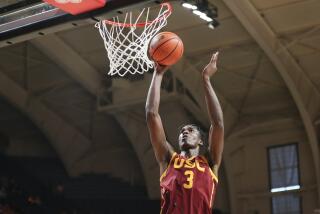SAGEBRUSH NAVY : Washington State Crew Still Suffers from Identity Crisis
- Share via
WAWAWAI, Wash. — Near a land-grant university in Southeastern Washington State, not too far from the Idaho border, sits a boat house surrounded by wheat fields and housing what once was laughingly called the Sagebrush Navy.
It is headquarters to the Washington State University crew team, a landlocked group of oarsmen whose access to water is at Wawawai, above the lower Granite Dam on the Snake River.
“You wouldn’t think of it out here in the middle of farmland,” said Ernie Iseminger, stroke for Washington State’s heavyweight eight-man shell. “But the word is spreading. Almost everyone on campus knows there is a crew team.”
Off campus, the Washington State crew still suffers from an identity crisis, despite some success in the Pacific 10 Conference and invitations to compete internationally.
“When we were down in San Diego, people kept calling us Washington and Western (Washington),” said Ken Struckmeyer, volunteer head coach. “We still get that when we leave the state. I think we’re just used to it now.”
The Cougar crew’s darkest day was Aug. 5, 1984, when a fire that might have been arson caused $10,000 damage to the new, $78,000 boathouse at Wawawai.
The shells hadn’t been moved in yet, but the fire delayed by eight months moving the 2,000-meter practice course from the turbulent water below Lower Granite Dam to the placid reservoir in the deep canyon.
But that same day, Washington State alum Paul Enquist won an Olympic gold medal in double sculls.
It’s been relatively smooth rowing since, except for the occasional wake from the huge barges traveling the slackwater of the Snake.
The men’s lightweight eight is two-time defending Pac-10 champion with a good shot at a third title, and Mike McQuaid, heavyweight stroke for three years, was named to last year’s All-Conference team.
With 100 men and women eligible, and 80 actually rowing, crew rivals football as the biggest sport on campus.
And Washington State has been invited by the Turkish Rowing Federation to a race Oct. 3 at Istanbul, where the university’s landlocked status is not widely recognized.
There wouldn’t be crew at Washington State if it weren’t for the hydroelectric dams on the Snake and lower Columbia rivers.
“In practice last week we set all sort of records,” said Struckmeyer, an associate professor of landscape architecture. “I think we have the best water on the coast.”
Practice sessions are 20 miles from campus, through the rolling farmland of the Palouse, famous for its wheat and for lending its name to the Appaloosa horse.
Crew is a club sport at Washington State, and the $5,000 it gets from student government makes it the least-funded of eight Pac-10 programs. Rowers pay an average of $400 a year to compete, mostly to cover transportation.
The lean budgets help make crew an attitude, says Iseminger, an education major from Federal Way, Wash.
“Being a club sport, we don’t get any recognition from the school,” he said. “So we do it for ourselves. All we need is eight guys willing to kill themselves.”
Iseminger said he wanted to compete at the Pac-10 level, but he wasn’t heavy enough to play football and the track team had enough high jumpers. Encouraged by a high school friend who had rowed, “I went to a crew meeting and fell in love with it.”
As stroke, Iseminger sets the pace for other rowers.
The heavyweight boat has finished no higher than fifth in the Pac-10. “Next year is the year we jump into the top four,” said Iseminger, a junior.
The lightweight boat has been successful because of experience, Struckmeyer said.
“I have 16 to 20 people trying for the boat. When you have the competition, you have the ability to put people in there who are working well,” he said.
“One other thing I attributed it to is kids who are quite smart. My stroke is Phi Beta Kappa, and my No. 2 man is Phi Beta Kappa, and several others have GPAs (grade point averages) over three-point. They know what they’re doing, and they’re smart enough to be able to handle it.”
Iseminger, sunburned from spending hours on the river, rows in the spring and fall, and, along with other club members, lifts weights and runs the steps in the football stadium.
“Money, time--it’s hard to deal with it,” he said. “I know what it’s like to not have money. It’s tough, but I wouldn’t want to be doing anything else.”
“We’ve unintentionally made it the way sports should be,” McQuaid said.
“Rowing is one of the true amateur sports left. There aren’t a lot of sponsorships and not a lot of money floating around the rowing world after you’re done.”
More to Read
Sign up for Essential California
The most important California stories and recommendations in your inbox every morning.
You may occasionally receive promotional content from the Los Angeles Times.













